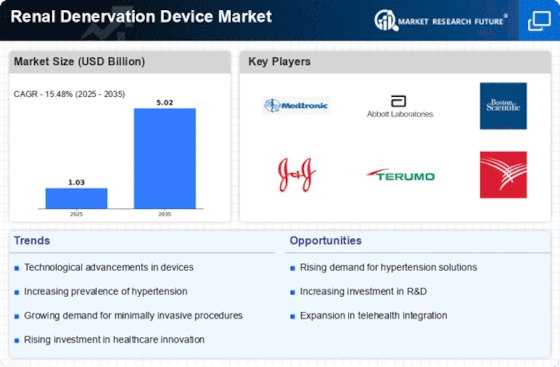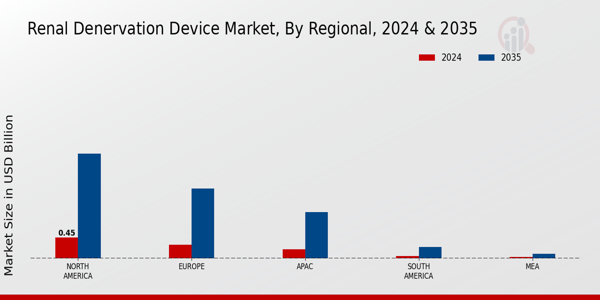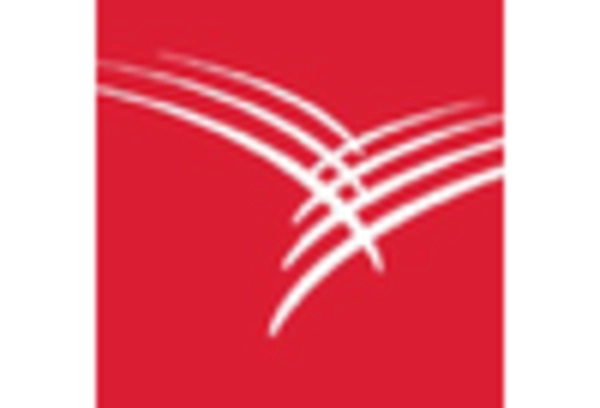Rising Prevalence of Hypertension
The increasing prevalence of hypertension is a primary driver for the Renal Denervation Device Market. As hypertension affects a significant portion of the adult population, the demand for effective treatment options is escalating. According to recent estimates, nearly 1.13 billion people worldwide are living with hypertension, which underscores the urgent need for innovative solutions. Renal denervation has emerged as a promising alternative for patients who are resistant to conventional antihypertensive therapies. This growing patient population is likely to propel the market forward, as healthcare providers seek to offer advanced treatment modalities that can effectively manage blood pressure levels. Furthermore, the rising awareness of hypertension's complications, such as cardiovascular diseases, is expected to further stimulate the demand for renal denervation devices, thereby enhancing market growth.
Regulatory Support and Approval Processes
Regulatory support and streamlined approval processes are essential drivers for the Renal Denervation Device Market. Regulatory bodies are increasingly recognizing the importance of renal denervation as a treatment for resistant hypertension, which has led to more favorable approval pathways for new devices. This supportive regulatory environment encourages manufacturers to invest in research and development, ultimately leading to the introduction of innovative renal denervation technologies. As more devices receive regulatory clearance, the market is likely to experience accelerated growth. Furthermore, the establishment of clear guidelines and standards for the use of renal denervation devices can enhance clinician confidence in these therapies, thereby promoting their adoption in clinical practice. The collaboration between regulatory agencies and industry stakeholders is crucial for ensuring that safe and effective renal denervation solutions are made available to patients.
Technological Innovations in Device Design
Technological advancements in the design and functionality of renal denervation devices are significantly influencing the Renal Denervation Device Market. Innovations such as improved catheter designs, enhanced energy delivery systems, and real-time imaging capabilities are making procedures safer and more effective. For instance, the introduction of multi-electrode systems allows for more efficient ablation of renal nerves, which may lead to better patient outcomes. The market is witnessing a surge in research and development activities aimed at refining these technologies, which could potentially increase the adoption rates of renal denervation procedures. As these devices become more user-friendly and effective, healthcare providers are likely to embrace them, thereby driving market growth. The integration of digital health technologies, such as remote monitoring, may also enhance patient engagement and adherence to treatment protocols.
Increasing Investment in Healthcare Infrastructure
The growing investment in healthcare infrastructure is a crucial driver for the Renal Denervation Device Market. Governments and private entities are increasingly allocating resources to enhance healthcare facilities, particularly in regions with high incidences of hypertension. This investment is likely to improve access to advanced medical technologies, including renal denervation devices. As healthcare systems evolve, the integration of these devices into standard treatment protocols is expected to rise. Moreover, the establishment of specialized hypertension clinics and centers of excellence may facilitate the adoption of renal denervation procedures. The expansion of healthcare infrastructure not only supports the availability of these devices but also fosters an environment conducive to clinical research and training, which is essential for the successful implementation of renal denervation therapies.
Growing Awareness and Education on Hypertension Management
The increasing awareness and education surrounding hypertension management are pivotal for the Renal Denervation Device Market. As healthcare professionals and patients become more informed about the risks associated with uncontrolled hypertension, there is a growing demand for effective treatment options. Educational campaigns and initiatives aimed at promoting awareness of renal denervation as a viable treatment alternative are likely to enhance its acceptance among both patients and healthcare providers. This heightened awareness may lead to an increase in referrals for renal denervation procedures, thereby driving market growth. Additionally, as more clinical evidence supporting the efficacy of renal denervation emerges, it is expected that healthcare providers will be more inclined to recommend these devices as part of comprehensive hypertension management strategies.


















Leave a Comment